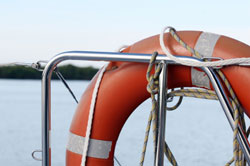
Sailing is a wonderful hobby, but as with any sport it can be dangerous. From novices to the most experienced sailors, it's vital that you're safe on the water. With 54% of lifeboat services carried out for pleasure craft, you cannot afford to take risks on the water.
We've put together some basic rules, ideal if you are new to sailing:
Equipment – Check your equipment before casting off
Things you will need to have onboard:
- Horseshoe lifebuoy
- An automatic light
- A danbouy
- A buoyant heaving line
Don't forget to take plenty of water, it's easy to become dehydrated at sea.
Other equipment to keep on board:
- Spare can of fuel clearly marked – petrol, diesel, two stroke
- Set of oars or auxiliary outboard
- Tow rope
- First aid kit
- Torch
- Day and night distress flares
- Fire extinguisher
- Bailer
- Anchor with adequate chain and rope
Weather - Always be aware of offshore winds
Check the weather of your destination before you sail, and be prepared to change your schedule. Also keep in mind that you may have to alter your route mid-way.
Boarding your boat – Keep your balance
Extra care needs to be taken when boarding sailboats as they are prone to capsizing. Step as far in to the centre of the boat as possible and never step on to the edge of the boat.
Capsizing – Practice, practice, practice
When it comes to safe sailing, capsizing is extremely important. Always practice in a controlled environment.
Man overboard - Don't panic!
Being prepared in a rescue situation gives everyone a fighting chance. Everyone onboard should wear a life jacket equipped with a whistle and mirror. A whistle which can function when wet can pierce through the noise of the choppiest waters. A lifebelt and dinghy should be thrown overboard immediately.
If you are the person overboard, try to maintain visual contact with the boat. Use your whistle and mirror to get your crew's attention.
Clothing - Always protect your head, hands and feet when sailing
Protection from the sun is very important because reflection from the sun on the water can cause sunburn. Apply a strong sunscreen to all areas of exposed skin and reapply regularly.
Wear warm protective clothing. Prolonged exposure to the cold can lead to exhaustion. A third of all body heat is lost through the head, so some form of head gear is essential. It will also protect you from sunstroke on sunny days.
Wearing gloves will protect your hands and keep them warm. Specialist gloves with non-slip reinforced fingers are best. Footwear should protect your feet and provide grip. Sailing shoes have non-slip soles. Never sail in bare feet – it's easy to slip on wet areas.
Hold on! – "One hand for the boat, one hand for yourself"
Always hold on to something and be prepared for any danger. A large wave or sudden gust of wind can toss your boat without warning. Always bend your knees for the best balance.
Wear a safety harness if sailing a keelboat. Clip it onto a solid object, leaving your hands free for handling line and sheets. Never use a safety harness on a dinghy, which may capsize.
Guard rails should be continuous around the upper deck. The rail ends should be secured with lashings or quick release slips so you can cut them to recover any man overboard.
Treat slippery surfaces with non-skid paint or stick on strips. Pay attention to tops of hatches and sloping coachroof sides which become walkways when the boat is heeled.
Final top tips
- Always sail at a recognised club or launching location
- Tell someone where you are going
- Have a healthy respect for the sea and sail within your limits
- Always remember, when it doubt, don't go out!
- If you hear thunder – turn back